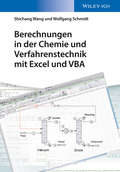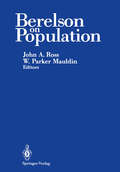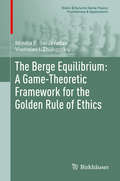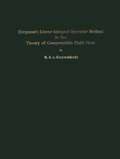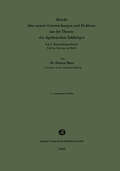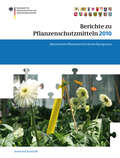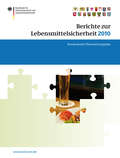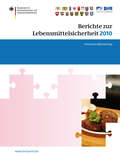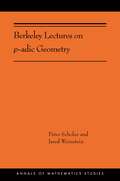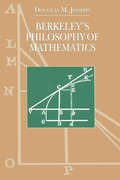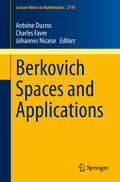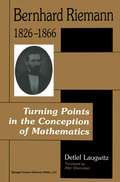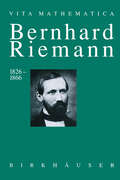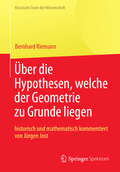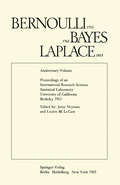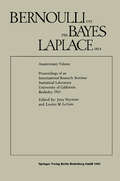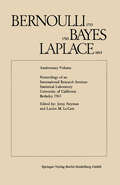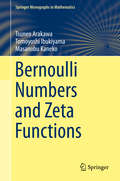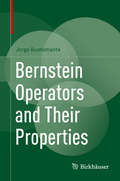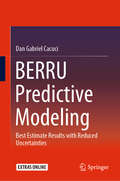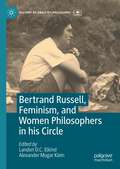- Table View
- List View
Berechnungen in der Chemie und Verfahrenstechnik mit Excel und VBA (Arbeitsbücher Verfahrenstechnik - für Studium und Beruf (VCH))
by Wolfgang Schmidt Shichang WangMit diesem Arbeitsbuch lernt der Anwender numerische Methoden in Excel-VBA kennen und zur Lösung von Problemen und Aufgabenstellungen aus Chemie und Verfahrenstechnik einzusetzen. Dabei steht die Anwendung auf einfache, grundlegende verfahrenstechnische Berechnungsmethoden im Vordergrund. Nach einer kurzen Einführung in Excel, Makros und die VBA-Programmierung, werden mathematische Methoden behandelt, die zur Berechnung verfahrenstechnischer und chemischer Problemstellungen erforderlich sind. Das Kernstück dieses Bandes ist die Anwendung des Gelernten auf reale Probleme aus dem Laboralltag, z.B. Gasgleichungen, Verbrennungs- und Polymerisationsrechnung.
Berelson on Population
by W. ParkerMauldin John A. RossBernard (Barney) Berelson had a major influence in the application of social science concepts and methods to population policy during the period from 1962 to 1980. This was the period when concern with population problems spread from a relatively small group of scholars and population activists to a much larger, diverse, international group of political and intellectual leaders and to the general public as well. There was an exponential growth in the number of scholars and service personnel in vari ous population and family specialities in this period. Barney came into the field with his appointment as Director of the Com munication Research Program of The Population Council in 1962. He had no previous training or experience in demography. Frank Notestein, Presi dent of The Population Council at the time, had the wisdom to appreciate the value and relevance of Barney's itTIpressive background in communica tion research and other social science areas, as well as his creative mind and leadership qualities. His influence on the Council's rapidly expanding program was so immediate and impressive that within a year, he was named Vice President. When Frank Notestein retired in 1968, Barney became President, a post he held for 6 very productive years.
The Berge Equilibrium: A Game-Theoretic Framework for the Golden Rule of Ethics (Static & Dynamic Game Theory: Foundations & Applications)
by Mindia E. Salukvadze Vladislav I. ZhukovskiyThe goal of this book is to elaborate on the main principles of the theory of the Berge equilibrium by answering the following two questions: What are the basic properties of the Berge equilibrium? Does the Berge equilibrium exist, and how can it be calculated? The Golden Rule of ethics, which appears in Christianity, Judaism, Islam, Buddhism, Confucianism and other world religions, states the following: “Behave towards others as you would like them to behave towards you." In any game, each party of conflict seeks to maximize some payoff. Therefore, for each player, the Golden Rule is implemented through the maximization of his/her payoff by all other players, which matches well with the concept of the Berge equilibrium. The approach presented here will be of particular interest to researchers (including undergraduates and graduates) and economists focused on decision-making under complex conflict conditions. The peaceful resolution of conflicts is the cornerstone of the approach: as a matter of fact, the Golden Rule precludes military clashes and violence. In turn, the new approach requires new methods; in particular, the existence problems are reduced to saddle point design for the Germeier convolution of payoff functions, with further transition to mixed strategies in accordance with the standard procedure employed by E. Borel, J. von Neumann, J. Nash, and their followers. Moreover, this new approach has proven to be efficient and fruitful with regard to a range of other important problems in mathematical game theory, which are considered in the Appendix.
The Bergman Kernel and Related Topics: Hayama Symposium on SCV XXIII, Kanagawa, Japan, July 2022 (Springer Proceedings in Mathematics & Statistics #447)
by Kengo Hirachi Takeo Ohsawa Shigeharu Takayama Joe KamimotoThis volume consists of 15 papers contributing to the Hayama Symposium on Complex Analysis in Several Variables XXIII, which was dedicated to the 100th anniversary of the creation of the Bergman kernel. The symposium took place in Hayama and Tokyo in July 2022. Each article is closely related to the Bergman kernel, covering topics in complex analysis, differential geometry, representation theory, PDE, operator theory, and complex algebraic geometry. Specifically, some papers address the L2 extension operators from a newly opened viewpoint after solving Suita's conjecture for the logarithmic capacity. They are also continuations of quantitative solutions to the openness conjecture for the multiplier ideal sheaves. The study involves estimates for the solutions of the d-bar equations, focusing on the existence of compact Levi-flat hypersurfaces in complex manifolds. The collection also reports progress on various topics, including the existence of extremal Kähler metrics on compact manifolds, Lp variants of the Bergman kernel, Wehrl-type inequalities, homogeneous Kähler metrics on bounded homogeneous domains, asymptotics of the Bergman kernels, and harmonic Szegő kernels and operators on the Bergman spaces and Segal-Bargmann spaces. Some of the papers are written in an easily accessible way for beginners. Overall, this collection updates how a basic notion provides strong insights into the internal relationships between independently found phenomena.
Bergman’s Linear Integral Operator Method in the Theory of Compressible Fluid Flow
by M.Z.v. KrzywoblockiBericht über neuere Untersuchungen und Probleme aus der Theorie der algebraischen Zahlkörper
by Helmut HasseBerichte zu Pflanzenschutzmitteln 2010: Jahresbericht Pflanzenschutz–Kontrollprogramm (BVL-Reporte #6.3)
by Saskia DombrowskiIn der Bundesrepublik Deutschland überwachen die Länderbehörden die Einhaltung der Vorschriften für das Inverkehrbringen und die Anwendung von Pflanzenschutzmitteln. 2010 wurden bundesweit 2558 Handelsbetriebe sowie 4909 land- und forstwirtschaftliche sowie Gartenbau-Betriebe kontrolliert. Darüber hinaus haben Kontrollstellen fast 100 Tausend Pflanzenschutzgeräte überprüft und die physikalischen, chemischen und technischen Eigenschaften von 157 Pflanzenschutzmitteln untersucht. Der vorliegende Bericht fasst die Ergebnisse dieser Kontrollen zusammen.
Berichte zum Wirtschaftlichen Verbraucherschutz 2009/2010 (BVL-Reporte #5.7)
by Saskia DombrowskiDie Zentrale Verbindungsstelle berichtet den für den Verbraucherschutz zuständigen obersten Landesbehörden jährlich umfassend und in anonymisierter Form über die im Rahmen des Verbraucherschutzdurchsetzungsgesetzes empfangenen und weitergeleiteten Ersuchen um Amtshilfe und Informationsaustausch. Das vorliegende Heft enthält die vom Bundesamt für Verbraucherschutz und Lebensmittelsicherheit (BVL) übermittelten Berichte der Jahre 2009 und 2010. Offizielle Veröffentlichung des BVL Berlin.
Berichte zur Lebensmittelsicherheit 2010: Bundesweiter Überwachungsplan 2010 (BVL-Reporte #6.1)
by Saskia DombrowskiDer Bericht fasst die Ergebnisse des Bundesweiten Überwachungsplans (BÜp) zusammen. Einmal jährlich wird mit dem BÜp die Durchführung amtlicher Kontrollen zur Einhaltung der lebensmittelrechtlichen, weinrechtlichen und tabakrechtlichen Vorschriften festgelegt. Um Lebensmittel, Kosmetika und Bedarfsgegenstände zu kontrollieren, wird je 1.000 Einwohner eine bestimmte Zahl an Produktproben untersucht. Der gemeinsame Bericht von Bund und Ländern ist eine Veröffentlichung des Bundesamts für Verbraucherschutz und Lebensmittelsicherheit.
Berichte zur Lebensmittelsicherheit 2010: Zoonosen-Monitoring (BVL-Reporte #6.4)
by Saskia DombrowskiZoonosen sind Infektionen, die zwischen Tieren und Menschen übertragen werden – Menschen können sich über Lebensmittel infizieren. Das Bundesamt für Verbraucherschutz und Lebensmittelsicherheit veröffentlicht mit dem Bericht die Ergebnisse des Zoonosen-Monitorings 2010. Dafür wurden repräsentative Daten über das Auftreten von Zoonoseerregern in Lebensmitteln, Futtermitteln und lebenden Tieren erfasst und ausgewertet. Weiterhin dient das Monitoring der Überwachung von Antibiotikaresistenzen bei Zoonoseerregern und anderen Mikroorganismen.
Berkeley Lectures on p-adic Geometry: (AMS-207) (Annals of Mathematics Studies #389)
by Peter Scholze Jared WeinsteinBerkeley Lectures on p-adic Geometry presents an important breakthrough in arithmetic geometry. In 2014, leading mathematician Peter Scholze delivered a series of lectures at the University of California, Berkeley, on new ideas in the theory of p-adic geometry. Building on his discovery of perfectoid spaces, Scholze introduced the concept of “diamonds,” which are to perfectoid spaces what algebraic spaces are to schemes. The introduction of diamonds, along with the development of a mixed-characteristic shtuka, set the stage for a critical advance in the discipline. In this book, Peter Scholze and Jared Weinstein show that the moduli space of mixed-characteristic shtukas is a diamond, raising the possibility of using the cohomology of such spaces to attack the Langlands conjectures for a reductive group over a p-adic field.This book follows the informal style of the original Berkeley lectures, with one chapter per lecture. It explores p-adic and perfectoid spaces before laying out the newer theory of shtukas and their moduli spaces. Points of contact with other threads of the subject, including p-divisible groups, p-adic Hodge theory, and Rapoport-Zink spaces, are thoroughly explained. Berkeley Lectures on p-adic Geometry will be a useful resource for students and scholars working in arithmetic geometry and number theory.
Berkeley's Philosophy of Mathematics (Science and Its Conceptual Foundations series)
by Douglas M. JessephIn this first modern, critical assessment of the place of mathematics in Berkeley's philosophy and Berkeley's place in the history of mathematics, Douglas M. Jesseph provides a bold reinterpretation of Berkeley's work. Jesseph challenges the prevailing view that Berkeley's mathematical writings are peripheral to his philosophy and argues that mathematics is in fact central to his thought, developing out of his critique of abstraction. Jesseph's argument situates Berkeley's ideas within the larger historical and intellectual context of the Scientific Revolution. Jesseph begins with Berkeley's radical opposition to the received view of mathematics in the philosophy of the late seventeenth and early eighteenth centuries, when mathematics was considered a "science of abstractions." Since this view seriously conflicted with Berkeley's critique of abstract ideas, Jesseph contends that he was forced to come up with a nonabstract philosophy of mathematics. Jesseph examines Berkeley's unique treatments of geometry and arithmetic and his famous critique of the calculus in The Analyst. By putting Berkeley's mathematical writings in the perspective of his larger philosophical project and examining their impact on eighteenth-century British mathematics, Jesseph makes a major contribution to philosophy and to the history and philosophy of science.
Berkeley's Philosophy of Mathematics (Science and Its Conceptual Foundations series)
by Douglas M. JessephIn this first modern, critical assessment of the place of mathematics in Berkeley's philosophy and Berkeley's place in the history of mathematics, Douglas M. Jesseph provides a bold reinterpretation of Berkeley's work. Jesseph challenges the prevailing view that Berkeley's mathematical writings are peripheral to his philosophy and argues that mathematics is in fact central to his thought, developing out of his critique of abstraction. Jesseph's argument situates Berkeley's ideas within the larger historical and intellectual context of the Scientific Revolution. Jesseph begins with Berkeley's radical opposition to the received view of mathematics in the philosophy of the late seventeenth and early eighteenth centuries, when mathematics was considered a "science of abstractions." Since this view seriously conflicted with Berkeley's critique of abstract ideas, Jesseph contends that he was forced to come up with a nonabstract philosophy of mathematics. Jesseph examines Berkeley's unique treatments of geometry and arithmetic and his famous critique of the calculus in The Analyst. By putting Berkeley's mathematical writings in the perspective of his larger philosophical project and examining their impact on eighteenth-century British mathematics, Jesseph makes a major contribution to philosophy and to the history and philosophy of science.
Berkeley's Philosophy of Mathematics (Science and Its Conceptual Foundations series)
by Douglas M. JessephIn this first modern, critical assessment of the place of mathematics in Berkeley's philosophy and Berkeley's place in the history of mathematics, Douglas M. Jesseph provides a bold reinterpretation of Berkeley's work. Jesseph challenges the prevailing view that Berkeley's mathematical writings are peripheral to his philosophy and argues that mathematics is in fact central to his thought, developing out of his critique of abstraction. Jesseph's argument situates Berkeley's ideas within the larger historical and intellectual context of the Scientific Revolution. Jesseph begins with Berkeley's radical opposition to the received view of mathematics in the philosophy of the late seventeenth and early eighteenth centuries, when mathematics was considered a "science of abstractions." Since this view seriously conflicted with Berkeley's critique of abstract ideas, Jesseph contends that he was forced to come up with a nonabstract philosophy of mathematics. Jesseph examines Berkeley's unique treatments of geometry and arithmetic and his famous critique of the calculus in The Analyst. By putting Berkeley's mathematical writings in the perspective of his larger philosophical project and examining their impact on eighteenth-century British mathematics, Jesseph makes a major contribution to philosophy and to the history and philosophy of science.
Berkovich Spaces and Applications (Lecture Notes in Mathematics #2119)
by Antoine Ducros Charles Favre Johannes NicaiseWe present an introduction to Berkovich’s theory of non-archimedean analytic spaces that emphasizes its applications in various fields. The first part contains surveys of a foundational nature, including an introduction to Berkovich analytic spaces by M. Temkin, and to étale cohomology by A. Ducros, as well as a short note by C. Favre on the topology of some Berkovich spaces. The second part focuses on applications to geometry. A second text by A. Ducros contains a new proof of the fact that the higher direct images of a coherent sheaf under a proper map are coherent, and B. Rémy, A. Thuillier and A. Werner provide an overview of their work on the compactification of Bruhat-Tits buildings using Berkovich analytic geometry. The third and final part explores the relationship between non-archimedean geometry and dynamics. A contribution by M. Jonsson contains a thorough discussion of non-archimedean dynamical systems in dimension 1 and 2. Finally a survey by J.-P. Otal gives an account of Morgan-Shalen's theory of compactification of character varieties. This book will provide the reader with enough material on the basic concepts and constructions related to Berkovich spaces to move on to more advanced research articles on the subject. We also hope that the applications presented here will inspire the reader to discover new settings where these beautiful and intricate objects might arise.
Bernhard Riemann 1826–1866: Turning Points in the Conception of Mathematics (Modern Birkhäuser Classics)
by Detlef LaugwitzThe name of Bernard Riemann is well known to mathematicians and physicists around the world. His name is indelibly stamped on the literature of mathematics and physics. This remarkable work, rich in insight and scholarship, is addressed to mathematicians, physicists, and philosophers interested in mathematics. It seeks to draw those readers closer to the underlying ideas of Riemann’s work and to the development of them in their historical context. This illuminating English-language version of the original German edition will be an important contribution to the literature of the history of mathematics.
Bernhard Riemann 1826–1866: Wendepunkte in der Auffassung der Mathematik (Vita Mathematica #10)
by Detlef LaugwitzDas Riemannsche Integral lernen schon die Schüler kennen, die Theorien der reellen und der komplexen Funktionen bauen auf wichtigen Begriffsbildungen und Sätzen Riemanns auf, die Riemannsche Geometrie ist für Einsteins Gravitationstheorie und ihre Erweiterungen unentbehrlich, und in der Zahlentheorie ist die berühmte Riemannsche Vermutung noch immer offen. Riemann und sein um fünf Jahre jüngerer Freund Richard Dedekind sahen sich als Schüler von Gauss und Dirichlet. Um die Mitte des 19. Jahrhunderts leiteten sie den Übergang zur "modernen Mathematik" ein, der eine in Analysis und Geometrie, der andere in der Algebra mit der Hinwendung zu Mengen und Strukturen. Dieses Buch ist der erste Versuch, Riemanns wissenschaftliches Werk unter einem einheitlichen Gesichtspunkt zusammenzufassend darzustellen. Riemann gilt als einer der Philosophen unter den Mathematikern. Er stellte das Denken in Begriffen neben die zuvor vorherrschende algorithmische Auffassung von der Mathematik, welche die Gegenstände der Untersuchung, in Formeln und Figuren, in Termumformungen und regelhaften Konstruktionen als die allein legitimen Methoden sah. David Hilbert hat als Riemanns Grundsatz herausgestellt, die Beweise nicht durch Rechnung, sondern lediglich durch Gedanken zu zwingen. Hermann Weyl sah als das Prinzip Riemanns in Mathematik und Physik, "die Welt als das erkenntnistheoretische Motiv..., die Welt aus ihrem Verhalten im un- endlich kleinen zu verstehen."
Bernhard Riemann „Über die Hypothesen, welche der Geometrie zu Grunde liegen“ (Klassische Texte der Wissenschaft)
by Bernhard RiemannIn diesem Werk wird einer der klassischen Texte der Mathematik umfassend historisch, mathematisch, physikalisch und philosophisch von Jürgen Jost ausführlich kommentiert und die gesamte Entwicklung dieser Disziplinen eingeordnet. Neben dem Urtext wird auch der historisch wichtige Kommentarteil von Hermann Weyl wiedergegeben.
Bernoulli 1713 Bayes 1763 Laplace 1813: Anniversary Volume
by Lucien M. Le Cam Jerzy Neyman1963 Anniversary Volume
Bernoulli 1713 Bayes 1763 Laplace 1813: Anniversary Volume Proceedings of an International Research Seminar Statistical Laboratory University of California, Berkeley 1963
by Jerzy Neyman Lucien M. Le CamBernoulli 1713, Bayes 1763, Laplace 1813: Anniversary Volume. Proceedings of an International Research Seminar Statistical Laboratory University of California, Berkeley 1963
by Jerzy Neyman Lucien M. Le CamBernoulli Numbers and Zeta Functions (Springer Monographs in Mathematics)
by Tsuneo Arakawa Tomoyoshi Ibukiyama Masanobu KanekoTwo major subjects are treated in this book. The main one is the theory of Bernoulli numbers and the other is the theory of zeta functions. Historically, Bernoulli numbers were introduced to give formulas for the sums of powers of consecutive integers. The real reason that they are indispensable for number theory, however, lies in the fact that special values of the Riemann zeta function can be written by using Bernoulli numbers. This leads to more advanced topics, a number of which are treated in this book: Historical remarks on Bernoulli numbers and the formula for the sum of powers of consecutive integers; a formula for Bernoulli numbers by Stirling numbers; the Clausen–von Staudt theorem on the denominators of Bernoulli numbers; Kummer's congruence between Bernoulli numbers and a related theory of p-adic measures; the Euler–Maclaurin summation formula; the functional equation of the Riemann zeta function and the Dirichlet L functions, and their special values at suitable integers; various formulas of exponential sums expressed by generalized Bernoulli numbers; the relation between ideal classes of orders of quadratic fields and equivalence classes of binary quadratic forms; class number formula for positive definite binary quadratic forms; congruences between some class numbers and Bernoulli numbers; simple zeta functions of prehomogeneous vector spaces; Hurwitz numbers; Barnes multiple zeta functions and their special values; the functional equation of the double zeta functions; and poly-Bernoulli numbers. An appendix by Don Zagier on curious and exotic identities for Bernoulli numbers is also supplied. This book will be enjoyable both for amateurs and for professional researchers. Because the logical relations between the chapters are loosely connected, readers can start with any chapter depending on their interests. The expositions of the topics are not always typical, and some parts are completely new.
Bernstein Operators and Their Properties
by Jorge BustamanteThis book provides comprehensive information on the main aspects of Bernstein operators, based on the literature to date. Bernstein operators have a long-standing history and many papers have been written on them. Among all types of positive linear operators, they occupy a unique position because of their elegance and notable approximation properties. This book presents carefully selected material from the vast body of literature on this topic. In addition, it highlights new material, including several results (with proofs) appearing in a book for the first time. To facilitate comprehension, exercises are included at the end of each chapter. The book is largely self-contained and the methods in the proofs are kept as straightforward as possible. Further, it requires only a basic grasp of analysis, making it a valuable and appealing resource for advanced graduate students and researchers alike.
BERRU Predictive Modeling: Best Estimate Results with Reduced Uncertainties
by Dan Gabriel CacuciThis book addresses the experimental calibration of best-estimate numerical simulation models. The results of measurements and computations are never exact. Therefore, knowing only the nominal values of experimentally measured or computed quantities is insufficient for applications, particularly since the respective experimental and computed nominal values seldom coincide. In the author’s view, the objective of predictive modeling is to extract “best estimate” values for model parameters and predicted results, together with “best estimate” uncertainties for these parameters and results. To achieve this goal, predictive modeling combines imprecisely known experimental and computational data, which calls for reasoning on the basis of incomplete, error-rich, and occasionally discrepant information. The customary methods used for data assimilation combine experimental and computational information by minimizing an a priori, user-chosen, “cost functional” (usually a quadratic functional that represents the weighted errors between measured and computed responses). In contrast to these user-influenced methods, the BERRU (Best Estimate Results with Reduced Uncertainties) Predictive Modeling methodology developed by the author relies on the thermodynamics-based maximum entropy principle to eliminate the need for relying on minimizing user-chosen functionals, thus generalizing the “data adjustment” and/or the “4D-VAR” data assimilation procedures used in the geophysical sciences. The BERRU predictive modeling methodology also provides a “model validation metric” which quantifies the consistency (agreement/disagreement) between measurements and computations. This “model validation metric” (or “consistency indicator”) is constructed from parameter covariance matrices, response covariance matrices (measured and computed), and response sensitivities to model parameters. Traditional methods for computing response sensitivities are hampered by the “curse of dimensionality,” which makes them impractical for applications to large-scale systems that involve many imprecisely known parameters. Reducing the computational effort required for precisely calculating the response sensitivities is paramount, and the comprehensive adjoint sensitivity analysis methodology developed by the author shows great promise in this regard, as shown in this book. After discarding inconsistent data (if any) using the consistency indicator, the BERRU predictive modeling methodology provides best-estimate values for predicted parameters and responses along with best-estimate reduced uncertainties (i.e., smaller predicted standard deviations) for the predicted quantities. Applying the BERRU methodology yields optimal, experimentally validated, “best estimate” predictive modeling tools for designing new technologies and facilities, while also improving on existing ones.
Bertrand Russell, Feminism, and Women Philosophers in his Circle (History of Analytic Philosophy)
by Landon D. C. Elkind Alexander Mugar KleinThis book examines Bertrand Russell’s complicated relationships to the women around him, and to feminism more generally. The essays in this volume offer scholarly reassessments of these relationships and their import for the history of feminism and of analytic philosophy.Russell is a founder of analytic philosophy. He has also been called a feminist due to his public, decades-long advocacy for women’s rights and equality of the sexes. But his private behavior towards wives and sexual partners, and his apparently dismissive (occasionally public) responses to some women philosophers, raises the question of what sort of feminist (or chauvinist) Russell actually was.Focusing on women in Russell’s circle of acquaintance, including feminist activists and his philosophical interlocutors, this book casts new light on a timeless thinker’s feminism and the women who played critical roles in the making of analytic philosophy.
